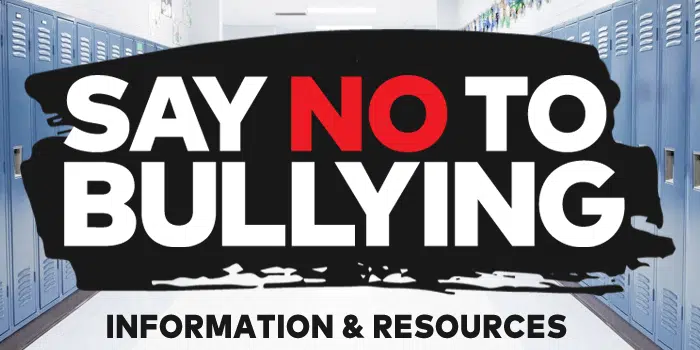
1 in 5 students ages 12-18 has been bullied at school
160,000 teens have skipped school because of bullying
62% of school staff have witnessed bullying in the last month
This school year, help your kids “Say NO To Bullying”
Scroll down for advice from StopBullying.gov
-Kids who know what bullying is can better identify it. They can talk about bullying if it happens to them or others. Kids need to know ways to safely stand up to bullying and how to get help.
-Encourage kids to speak to a trusted adult if they are bullied or see others being bullied. The adult can give comfort, support, and advice, even if they can’t solve the problem directly. Encourage the child to report bullying if it happens.
-Talk about how to stand up to kids who bully. Give tips, like using humor and saying “stop” directly and confidently. Talk about what to do if those actions don’t work, like walking away
-Talk about strategies for staying safe, such as staying near adults or groups of other kids.
-Urge them to help kids who are bullied by showing kindness or getting help.
Research tells us that children really do look to parents and caregivers for advice and help on tough decisions. Sometimes spending 15 minutes a day talking can reassure kids that they can talk to their parents if they have a problem. Start conversations about daily life and feelings with questions like these:
- What was one good thing that happened today? Any bad things?
- What is lunch time like at your school? Who do you sit with? What do you talk about?
- What is it like to ride the school bus?
- What are you good at? What would do you like best about yourself?
Talking about bullying directly is an important step in understanding how the issue might be affecting kids. There are no right or wrong answers to these questions, but it is important to encourage kids to answer them honestly. Assure kids that they are not alone in addressing any problems that arise. Start conversations about bullying with questions like these:
- What does “bullying” mean to you?
- Describe what kids who bully are like. Why do you think people bully?
- Who are the adults you trust most when it comes to things like bullying?
- Have you ever felt scared to go to school because you were afraid of bullying? What ways have you tried to change it?
- What do you think parents can do to help stop bullying?
- Have you or your friends left other kids out on purpose? Do you think that was bullying? Why or why not?
- What do you usually do when you see bullying going on?
- Do you ever see kids at your school being bullied by other kids? How does it make you feel?
- Have you ever tried to help someone who is being bullied? What happened? What would you do if it happens again?
There are simple ways that parents and caregivers can keep up-to-date with kids’ lives.
- Read class newsletters and school flyers. Talk about them at home.
- Check the school website
- Go to school events
- Greet the bus driver
- Meet teachers and counselors at “Back to School” night or reach out by email
- Share phone numbers with other kids’ parents
Kids learn from adults’ actions. By treating others with kindness and respect, adults show the kids in their lives that there is no place for bullying. Even if it seems like they are not paying attention, kids are watching how adults manage stress and conflict, as well as how they treat their friends, colleagues, and families.



